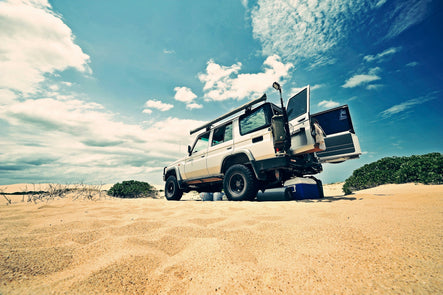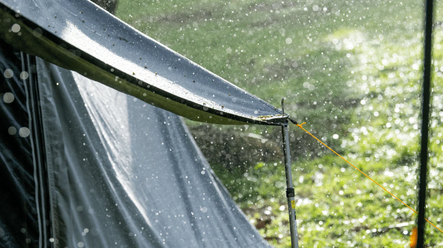The Benefits and Safety of Using a Winch
When it comes to 4WD adventures, a winch stands out as a reliable tool ready to bail you out when the going gets tough. The importance of having a winch attached to your 4WD cannot be overstated. Winches are designed to assist in difficult situations, such as when your vehicle is stuck in mud, sand or even snow. They can also be used for tasks such as towing objects or vehicles, lifting heavy objects and pushing other vehicles out of the way.
In this comprehensive guide, we will explore the critical aspects of winch usage, from understanding the key components and choosing the right winch for your needs to mastering safe operating procedures and advanced techniques for diverse off-road scenarios. Whether you're a seasoned off-roader or a novice adventurer, this guide aims to equip you with the knowledge and skills to make the most of this indispensable tool.
Understanding the Mechanics of a Winch
Let's start with the basics—how does a winch work? Whether it's hydraulic, electric, or mechanical, the fundamental concept remains consistent. A winch employs a motor to wind a cable or rope, providing the necessary pulling force to extricate a stuck vehicle.
When choosing a winch for your 4WD, consider the type that aligns with your needs. Electric winches are popular for their ease of use and versatility, while hydraulic winches boast robust power for heavy-duty situations. Mechanical winches, though less common, may suit specific preferences and scenarios.
The Benefits of Using a Winch
A winch is not just another accessory for your 4WD—it's a game-changer. Picture this: you find yourself mired in mud during an off-road expedition. A winch transforms this seemingly dire situation into a manageable task. It can pull you out of tough spots, saving time, effort, and perhaps even preventing a life-threatening predicament.
Below are just some of the benefits of installing a winch to your 4WD.
-
Mud Extrication:
Picture yourself knee-deep in mud during an off-road venture. A winch is capable of exerting the necessary force to pull your 4WD out of the mire. This not only saves time and effort but prevents a potentially hazardous situation where being stranded in mud could lead to adverse consequences. -
Crossing Rivers:
When facing river crossings, a winch serves as a safety net. Unforeseen underwater obstacles can impede progress, and a winch provides the means to navigate through challenging currents. For example, if your vehicle loses traction in a riverbed, a winch can pull it to safety, preventing it from being carried away by the water. -
Tackling Steep Inclines:
The versatility of a winch shines when confronting steep inclines that exceed your vehicle's climbing capabilities. Instead of risking a hazardous ascent or descent, a winch allows for a controlled and safe manoeuvre. This capability is particularly crucial in mountainous terrains, where steep gradients can pose significant challenges. -
Save Time and Effort:
One of the primary advantages of a winch is its ability to expedite recovery efforts. Instead of relying on manual labour, which can be time-consuming and physically demanding, a winch streamlines the process. This time efficiency is invaluable, especially in adverse conditions or when facing tight schedules during off-road expeditions. -
Prevent Life-Threatening Situations:
The life-saving potential of a winch cannot be overstated. Imagine being stuck in a remote area with no immediate assistance available. A winch can be the difference between a prolonged, potentially dangerous situation and a timely and secure recovery. In scenarios where swift action is crucial, a winch becomes a critical tool in preventing life-threatening predicaments. -
Terrain Versatility:
A winch transforms your 4WD into a versatile off-road machine. Seemingly impassable routes, whether due to mud, rivers, or inclines, become conquerable challenges. This adaptability expands your exploration possibilities, allowing you to venture into terrains that would be off-limits without the assistance of a winch. -
Self-Reliance:
Having a winch instils a sense of self-reliance during off-road journeys. Instead of solely depending on external assistance, your 4WD becomes more autonomous. This self-sufficiency not only enhances the overall off-road experience but also contributes to a heightened sense of confidence in tackling diverse and unpredictable terrains.
Whether it's navigating through challenging terrains, crossing rivers, or tackling steep inclines, a winch enhances your 4WD's capability, turning seemingly impassable routes into conquerable challenges.
How to Use a Winch Safely
Now, let's delve into the nitty-gritty of safe winching. The process involves more than just hooking a cable and hitting a button. Begin by understanding your winch's weight rating—it's the key to safe and effective operation. Exceeding this limit not only jeopardises your safety but also risks damaging the winch.
Follow a systematic approach when using a winch. Securely anchor the winch point, double-check your connections, and engage the winch slowly and steadily. Regular maintenance is crucial—keep the snatch block lubricated and inspect the cable for signs of wear and tear.
To fully prepare for the unexpected, consider seeking professional training to delve deeper into the intricacies of winching. Learning from experienced instructors equips you with the confidence and expertise to handle diverse off-road scenarios. As with any skill, practice makes perfect, and maintaining a proactive approach to refining your winching abilities is key.
Planning your next off-road adventure? The team at Camping Adventures is here to help you safely and responsibly use your 4WD recovery gear.
More Winch Safety Tips
Inspect Equipment Regularly:
Regularly check the winch, cables, and connections for signs of wear or damage, ensuring optimal functionality and preventing potential hazards during operation.
Know Your Winch's Capacity:
Adhere to the manufacturer's weight ratings to avoid overloading the winch, safeguarding against equipment failure and maintaining safe winching practices.
Choose Stable Anchor Points:
Always secure the winch to stable and robust anchor points to prevent unexpected movement or dislodging during operation.
Use Dampeners on Cables:
Employ cable dampeners when winching to mitigate the risk of cable snapback, protecting yourself and others from potential injury.
Maintain Proper Cable Spooling:
Ensure the cable spools evenly on the winch drum to prevent kinks, tangles, or uneven winding, reducing the risk of cable damage and ensuring smooth operation.
Stay Clear During Operation:
Maintain a safe distance from the winch and its components during operation to avoid injury in case of cable breakage or unexpected movements.
Engage Safety Locks:
Utilise safety locks and mechanisms on the winch to secure the load, preventing accidental releases and ensuring controlled winching.
Keep Hands Clear:
Avoid placing hands or any body part near the winch or cable while in operation to prevent injuries caused by sudden movements or entanglement.
Practice Controlled Operation:
Operate the winch slowly and steadily, avoiding abrupt movements to maintain control and prevent equipment strain or failure.
Monitor Battery Levels:
Ensure your vehicle's battery is in good condition and charged adequately, as a weak battery may compromise winch performance and reliability.
Use a Snatch Block for Angled Pulls:
Employ a snatch block for angled pulls to maintain a straight line and distribute the load evenly, preventing cable stress and enhancing winching efficiency.
Follow Proper Rigging Techniques:
Adhere to recommended rigging practices to secure loads effectively, minimising the risk of load shifts or instability during winching.
Provide Clear Communication:
Establish clear communication with all involved parties during winching operations, ensuring everyone is aware of the procedures and potential hazards.
Avoid Excessive Speed:
Control the winching speed to prevent sudden jerks or movements, reducing the risk of equipment strain and maintaining safe winching practices.
Common Winching Mistakes to Avoid
Even with the best intentions, 4WD owners often make common winching mistakes that compromise safety. One frequent error is neglecting to clear the area around the vehicle, leading to potential hazards. Another is underestimating the importance of properly spooling the cable onto the winch drum, preventing tangles and ensuring smooth operation.
Avoiding these mistakes requires diligence and attention to detail. Always survey the winching environment, clear obstacles, and double-check your equipment before initiating the winch.
The Bottom Line
A winch is not just a tool; it's a lifeline for 4WD enthusiasts navigating unpredictable terrains. The benefits of having a winch extend beyond convenience—it's a safety net that can mean the difference between a minor setback and a major predicament. As you embark on your off-road adventures, embrace the power of winches, but do so responsibly. Safeguard yourself and others by understanding the mechanics, avoiding common mistakes, and continuously honing your winching skills. Here's to safe and effective winching, ensuring your 4WD journeys remain thrilling yet secure.
Winches and More at Camping Adventures
We invite you to visit our indoor showroom and explore our impressive collection of 4x4 and RV accessories. At our showroom, you can witness firsthand the high quality and wide variety of products we offer. Book a viewing or demonstration to get a closer look and experience our accessories in action.







